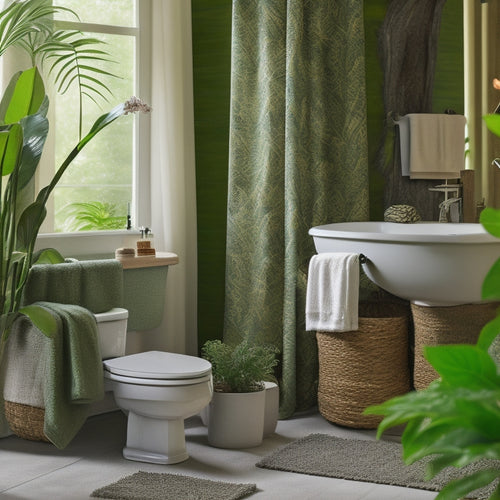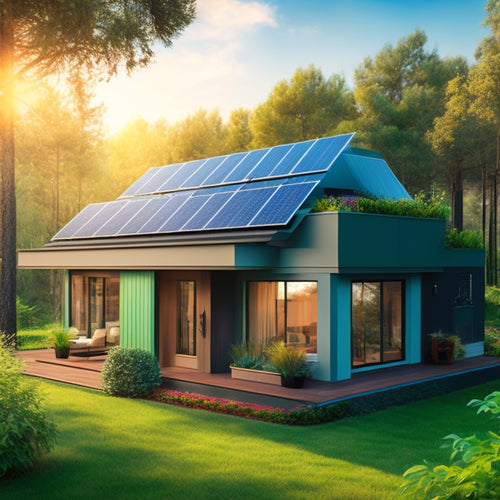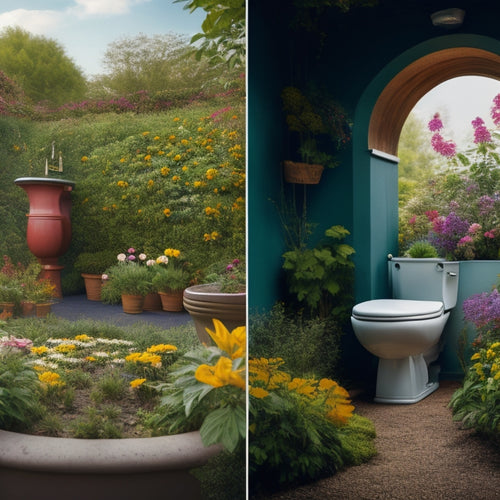
7 Essential Rainwater Harvesting Tips for Aquaponics Success
Share
To guarantee success in your aquaponics system, you'll need to excel at rainwater harvesting. Start by choosing the right storage tank, selecting durable materials and sizing it correctly based on your roof catchment area and expected rainfall. Position it wisely, filter out debris and contaminants, and don't forget to install a first flush device to divert initial water flow containing impurities. Regular maintenance is vital, including cleaning gutters, checking for leaks, and monitoring water quality. By following these essential tips, you'll be well on your way to creating a thriving aquaponics system - and there's more to uncover to take your system to the next level.
Key Takeaways
- Choose a durable, non-toxic storage tank that is sized correctly for your roof catchment area and expected rainfall.
- Position the tank to minimize water loss, and ensure gutters are securely fastened to prevent sagging or collapse.
- Filter out debris and contaminants using mesh screens, sediment traps, and UV light treatment to maintain optimal water quality.
- Regular maintenance is crucial, including cleaning gutters, checking for leaks, and monitoring water quality to prevent system inefficiencies.
- Connect rainwater harvesting to aquaponics by ensuring compatible design, using food-grade pipes, and implementing screens or filters to prevent contamination.
Choose the Right Storage Tank
Since you're investing in an aquaponics system, selecting the right storage tank for rainwater harvesting is vital.
You'll want to take into account tank materials that are durable, non-toxic, and resistant to corrosion. Food-grade polyethylene or stainless steel tanks are excellent options.
In addition, incorporating renewable energy sources, such as solar-powered fast charging, can further enhance the sustainability of your aquaponics system.
Size considerations are also important, as you'll need to store enough water to supply your aquaponics system during dry spells.
Calculate your tank size based on your roof's catchment area, rainfall intensity, and system demand. A general rule of thumb is to store at least 1 gallon of water per square foot of roof area.
Be sure to research local regulations and verify your tank meets all necessary safety and health standards.
Position for Maximum Collection
One key factor in maximizing rainwater collection is strategically positioning your storage tank and gutters.
You'll want to place your tank under the downspout to minimize pipe length and reduce water loss. Consider the roof angle, too - a steeper angle can increase water flow and reduce debris accumulation.
Implementing renewable energy solutions can also reduce your reliance on fossil fuels and lower your carbon footprint. By incorporating solar panels or wind energy, you can power your aquaponics system sustainably.
Downspout placement is also essential; position them to capture water from the entire roof surface. Make sure the gutters are securely fastened to the roof to prevent sagging or collapse.
Filter Out Debris and Contaminants
You'll want to make sure your harvested rainwater is free from contaminants that can harm your aquaponic system.
To do this, you'll need to filter out large debris, remove fine sediment, and eliminate waterborne pathogens.
Additionally, considering the high upfront costs of solar-powered EV charging systems, ranging from $15,000 to $30,000 for home installations solar EV charging costs, it's crucial to prioritize energy efficiency in your aquaponic system as well.
Screen Out Large Debris
To guarantee your rainwater harvesting system provides a consistent supply of clean water for your aquaponics setup, it's vital to screen out large debris and contaminants from the collected rainwater.
You'll want to remove debris types like leaves, twigs, and roof material that can clog your system or harm your fish. Effective screening methods include installing mesh screens or filters with openings of 1-2 mm to catch larger particles.
Implementing solar-powered systems can also reduce operational costs and improve energy efficiency, making your aquaponics setup more sustainable. Additionally, integrating energy storage systems can enhance grid resiliency and optimize charging efficiency.
You can also use a first flush device, which allows the first flow of water from the roof to be diverted, taking any debris with it, and then allows clean water to flow into your tank.
Remove Fine Sediment
After large debris is screened out, it's vital to filter out fine sediment and contaminants that can still be present in the rainwater.
You don't want these particles clogging your system or affecting water quality. Implementing energy storage systems, like those used in electric bus and depot management grid connection and compliance, can also help mitigate peak demand charges and guarantee a stable power supply for your aquaponics system.
To remove fine sediment, consider these methods:
- Install sediment traps to capture suspended particles
- Perform regular sediment analysis to identify contaminants
- Use mesh filters with a small micron rating to catch fine debris
- Implement a multi-stage filtration system for thorough cleaning
- Incorporate natural filters like gravel or sand to remove impurities
Eliminate Waterborne Pathogens
Pure water is the lifeblood of a thriving aquaponics system, and eliminating waterborne pathogens is essential to maintaining a healthy environment for your plants and fish. You'll want to implement effective water treatment strategies to prevent the spread of disease.
| Pathogen Prevention Method | Description | Effectiveness |
|---|---|---|
| UV Light Treatment | Exposes water to UV light to kill bacteria and viruses | High |
| Chlorination | Adds chlorine to water to kill bacteria and viruses | Medium |
| Sedimentation | Allows particulate matter to settle to the bottom of a tank | Low |
| Filtration | Removes debris and particulate matter from water | High |
| Boiling | Heats water to kill bacteria and viruses | High |
First Flush Devices Are Essential
Your aquaponics system's integrity depends on the quality of water it receives, and first flush devices play an essential role in safeguarding that integrity.
These devices divert the initial flow of water from your roof, which may contain debris, dirt, and other contaminants, away from your tank. This guarantees that only clean water enters your system, protecting your plants and fish from harm.
Here's what you can expect from a first flush device:
- Improved water quality, free from contaminants and debris
- Reduced risk of clogged pipes and pumps
- Increased efficiency and longevity of your system
- Healthier plants and fish, thanks to clean water
- Peace of mind, knowing your system is protected from harm
Regular Maintenance Is Key
You'll need to perform routine checks to guarantee your rainwater harvesting system is running smoothly.
This includes cleaning your gutters regularly to prevent debris buildup, which can clog your system.
You should also inspect your pipes and connections for leaks, as even small cracks can lead to significant water losses over time.
Clean the Gutters
The gutters' role in rainwater harvesting for aquaponics is vital, as they're responsible for collecting and directing rainwater towards the storage system.
You need to guarantee they're functioning efficiently to maximize rainwater efficiency. Regular gutter cleaning is important to prevent debris buildup, which can clog the system and reduce water flow.
-
Leaves and twigs can clog gutters, causing water to overflow and reducing the system's efficiency.
-
Debris accumulation can lead to rust and corrosion, shortening the lifespan of your gutters.
-
Clean gutters guarantee proper water flow, reducing the risk of waterlogging and structural damage.
-
Regular maintenance helps identify potential issues before they become major problems.
-
By cleaning your gutters, you'll enjoy a more efficient and sustainable aquaponics system.
Check for Leaks
Regular inspections are vital to identify leaks in your rainwater harvesting system, guaranteeing it operates at peak efficiency. You must regularly check for signs of water damage, corrosion, or mineral buildup around connections, valves, and pipes. Leak detection is essential, as undetected leaks can lead to water loss, contamination, and system failure.
| Leak Detection Method | Description | Frequency |
|---|---|---|
| Visual Inspection | Look for signs of water damage, corrosion, or mineral buildup | Monthly |
| Pressure Test | Check system pressure to identify potential leaks | Quarterly |
| Sensor Monitoring | Use sensors to detect changes in water level or pressure | Continuously |
Mastering repair techniques, such as replacing worn-out gaskets or tightening loose connections, will help you address leaks promptly and effectively. By staying on top of leak detection and repair, you'll guarantee your rainwater harvesting system operates efficiently and reliably, giving you the freedom to focus on your aquaponics success.
Connect to Your Aquaponics System
Connecting your rainwater harvesting system to your aquaponics setup is an essential step in creating a sustainable and thriving ecosystem.
By integrating these two systems, you'll reap the rainwater benefits and create a closed-loop system that's both efficient and environmentally friendly.
Here's how to connect them:
-
Confirm your aquaponics system is designed to accept rainwater, and adjust the pH and temperature levels accordingly.
-
Use food-grade pipes and fittings to connect the rainwater harvesting system to your aquaponics setup.
-
Install a first flush device to divert the initial flow of water, which may contain debris and contaminants.
-
Add a screen or filter to prevent fish and plants from escaping or getting sucked into the rainwater harvesting system.
-
Regularly inspect and maintain the connection points to prevent leaks and guarantee a smooth flow of water.
Monitor Water Quality Closely
With rainwater flowing into your aquaponics system, you're now responsible for ensuring the water quality remains ideal for your fish and plants. Regular monitoring is essential to prevent water quality issues that can harm your aquatic life. You'll need to check pH balance, nutrient levels, and other parameters regularly.
| Parameter | Ideal Range | Monitoring Frequency |
|---|---|---|
| pH | 6.5-8.5 | Daily |
| Ammonia | 0-0.5 ppm | Daily |
| Nitrite | 0-1 ppm | Weekly |
Frequently Asked Questions
Can I Use Rainwater Harvesting for Small-Scale Aquaponics Systems?
You can definitely use rainwater harvesting for small-scale aquaponics systems, but you'll need to verify rainwater quality by installing a proper filtration system and prioritize regular system maintenance to prevent contamination and assure a healthy aquaponics ecosystem.
How Often Should I Inspect My Rainwater Harvesting System?
You're one step away from disaster if you don't inspect your rainwater harvesting system regularly - aim for weekly checks during heavy rainfall and monthly during dry spells to guarantee system maintenance and catch potential issues before they escalate.
Are There Any Specific Pipe Materials for Rainwater Harvesting?
When selecting pipes for rainwater harvesting, you'll want to prioritize material durability to guarantee a leak-free system. You should opt for UV-resistant, BPA-free pipes made from materials like HDPE, PVC, or stainless steel, which can withstand outdoor exposure and harsh weather conditions.
Can I Connect Multiple Downspouts to a Single Storage Tank?
Surprisingly, you're not limited to one downspout per tank! You can connect multiple downspouts to a single storage tank, but don't forget to take into account downspout design and tank capacity to guarantee efficient water collection and storage.
Are Rainwater Harvesting Systems Suitable for Areas With Low Rainfall?
You're wondering if rainwater harvesting systems are viable in low-rainfall areas. While they can still be effective, you'll need to prioritize rainwater efficiency and implement drought strategies, such as smaller tanks and supplemental water sources, to maintain a reliable supply.
Related Posts
-

Sustainable Scrubbing: Top Bathroom Solutions for Earth-Conscious Homes
You're taking an important step towards creating a more sustainable home by switching to eco-friendly bathroom cleani...
-

3 Green HVAC Filters for Solar-Powered Homes
When outfitting your solar-powered home with an HVAC system, you'll want to choose filters that align with your commi...
-

Why Transform Human Waste Into Garden Gold?
By changing human waste into garden gold, you'll reduce waste management costs, support sustainable agriculture, and ...


